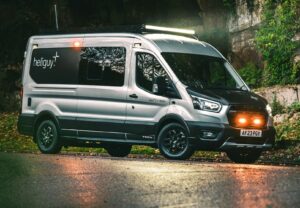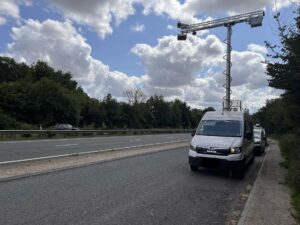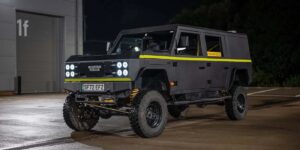
The use cases of such technology can vary significantly, but all require complete reliability and versatility of the products involved – to carry out complex missions that both protect the lives of both the public as well as servicepeople.
Recent months have seen a series of new product launches in the sector, including a Drone Command Unit, designed and developed in partnership between Heliguy and Goole-based Venari.
The custom-modified Ford Transit Trail has been designed as a modular, adaptable, and connected vehicle which meets the needs of current and future drone operations.
This includes real-time communications, live monitoring capabilities, airspace monitoring, data transmission and processing, and drone-in-a-box operations.
It features a Flat Panel Starlink ROAM, capable of providing satellite communications, even while on the move, and the rear compartment has a dock, enabling commanders to view the drone feed without interfering with the operation.
In addition, there is an integrated power supply, comprising two 3000W petrol generators and a pair of 160W solar panels on the roof.
The van also includes a personal welfare station with refrigerated cool-box and microwave, as well as on-board weather station and equipment storage area.
Mark Brickhill, Managing Director of Venari, said: “Our command vehicle can simultaneously operate multiple drones for example for police to cover a football match, protest march, or hostage rescue by specialist firearms officers or the military.
“It can simultaneously stream critical information in real-time to a remote command headquarters and can also operate multiple drones even when flying at different locations.
“The potential civil applications for transport, infrastructure, and utilities companies are also significant – at a fraction of the cost of using helicopters.”
Meanwhile, the Joint Operations Roads Policing Unit of Hampshire and Isle of Wight Constabulary and Thames Valley Police have been enforcing road safety with an AI-equipped camera van – a modified MAN TGE – to detect drivers illegally and dangerously driving.
Officers have deployed the Sensor Test Vehicle with “Heads-Up” solution from Acusensus, with 3D high definition radar that measures speed, range and angle for all targets across multiple lanes.
The van is equipped with two cameras which capture suspected offences of driving without a seatbelt, or using a mobile phone.
One camera is set at a shallow angle to identify mobile phone use to the ear, and to see whether the seatbelt is going across the body or hanging down behind the driver.
The second camera has a steep view, providing visibility of mobile phone use low down, to detect behaviour such as texting near the steering wheel or door.
This second camera also gives further evidence of seatbelt use by being able to check the presence of the lap portion of the belt, and confirm that the seatbelt is clipped into the buckle.
All images of possible offences are automatically captured then sent to be checked by two separate UK teams from company AECOM, before being provided to the police for their review.
In a recent week-long operation, the van identified 86 drivers suspected of using a phone and 273 motorists or passengers suspected of not wearing a seatbelt.
Geoff Collins, UK General Manager for Acusensus, said: “The ‘Heads Up’ system is a perfect example for how AI technology can be used to improve road safety.
“Distracted drivers are a significant hazard for everyone, whilst those not wearing a seatbelt are far more likely to be killed in a collision – the Acusensus technology can help to change behaviours, reducing the casualty toll on our roads.”

Designed, engineered, and built in Britain, the Munro is the first light vehicle to enter production in Scotland in more than four decades.
The 4X4 is the first MK_1 special edition tailored to the requirements of Mountain Rescue and Fire Services who need a rugged, all-terrain vehicle capable of reaching casualties and wildfires in remote and challenging terrain.
The release of the vehicle follows extensive consultation and discussions with Scottish, English and Welsh mountain rescue teams and discovery sessions with several regional Fire Services.
Key attributes include roof-mounted blue lights and the space to carry a stretcher safely within the protection of the vehicles, along with three passengers and all their kit.
The rear bed of the Munro MK_1 Truck accommodates a 1050kg Euro Pallet payload, while the Performance model has a 3,500kg maximum braked towing capacity for haulage of any cargo from specialist technical rescue tools to water bowsers and disaster relief equipment.
Producing a peak power output of 375/280kw combined with instantly available 700Mn/516ft-lb of torque, the Munro MK_1 can travel from 0-60mph in 4.9 seconds.
A 220KW electric motor and a choice of Utility and Range variants are also offered.
Replenishing the 82.4kWh battery from 15 to 80% can be done in 36 minutes using a 100kW DC charger.
With a fully charged battery, the MK_1 has a range of more than 190 miles, enabling it to operate off-road for up to 16 hours on a single battery charge.
Russell Peterson, Munro CEO and Co-Founder said: “We have consulted with multiple Mountain Rescue Teams to best understand their unique demands for an all-terrain stretcher bearing vehicle capable of crossing the toughest of terrain.
“Our no-nonsense vehicles are suited to the toughest of jobs in the harshest of terrains.”
Cambridge-based VNC Automotive, a specialist in automotive software and hardware products, recently released Cobalt Cube 2.0, the latest iteration of its in-vehicle connectivity product for police, fire, ambulance, and rescue vehicles.
The Cobalt Cube 2.0 comes with a redesigned user interface that is both clearer and more ergonomic.
Equipped with enterprise device management, fleet specific apps, services, and settings can be seamlessly activated, updated, and managed in bulk.

There is no doubt that commercial vehicle manufacturers and suppliers in the UK will continue to play a major role in keeping emergency response services supplied with the most up-to-date equipment, trucks, vans and conversions over the coming years.








